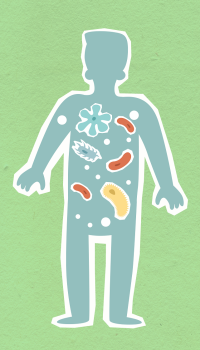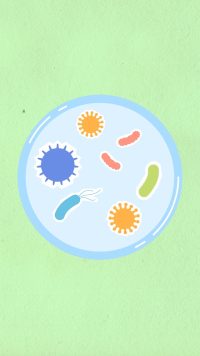 No man is an island, but every human body is a multiverse containing hundreds of worlds and thousands of different species. This inner environment is known as the human microbiome.
No man is an island, but every human body is a multiverse containing hundreds of worlds and thousands of different species. This inner environment is known as the human microbiome.
No guts, no glory
Every day, trillions of microscopic organisms live, travel, work, interact, multiply, and die inside us. Thousands of species of bacteria, fungi, protists and archaea all call our bodies their home.
Although they’re simple and tiny, together they form communities that interact in complicated ways with each other as well as the organs they inhabit. As part of a symbiotic system, our bodies rely on them just as they rely on us.
Everyone’s microbiome differs in its number, types, and proportions of species. The unique composition of a person’s micro menagerie can be affected by anything from their location to their stress level to their love life to the method of their birth delivery.
However, there are enough commonalities between people that scientists have been able to start singling out specific species and learning what they’re actually getting up to.
As well as being affected by things humans do, the micro-organisms that live in our bodies can also profoundly affect us. Most of us will be familiar with the ominous lower gurglings after a dubious takeaway, but helpful bacteria in our digestive system also help release vitamins from food that our bodies can’t extract by themselves.
Now new research has described how some kinds of gut bacteria might be involved in the development of type 2 diabetes, while others might help protect against it.
 The germ of an idea
The germ of an idea
For years, scientists have suspected that gut bacteria might have some role to play in type 2 diabetes.
Previous studies comparing the kinds of bacteria inside diabetic and non-diabetic people’s tums found that the mix of species were slightly different between the two groups.
Compared to non-diabetics, diabetic people had fewer of the kinds of bacteria that secrete the chemical butyrate. The bacteria create butyrate by fermenting carbohydrates that the human body can’t digest, and studies with mice had shown that butyrate was beneficial for metabolism and protective against insulin resistance and obesity. However, the scientists could not identify why diabetics didn’t have as many butyrate-producing bacteria, or the effect the relative lack of butyrate had on their diabetes.
A new study has looked into this mystery to try and identify the exact species involved and figure out what exactly is going on.
 Bugging the question
Bugging the question
The Microbiome and Insulin Longitudinal Evaluation Study (MILES) was designed to investigate how exactly insulin, type 2 diabetes, and the microbiome are linked together.
For 5 years researchers from the MILES study have collected and studied data from Black and non-Hispanic white participants between the ages of 40 and 80. Information gathered from this cohort has been used in many studies already – one finding that being born via cesarean section is associated with a higher risk of developing prediabetes and diabetes in later life.
In this study, researchers asked 352 non-diabetic people to collect three stool samples, which were genetically sequenced to reveal the different species making up each person’s unique digestive microbiome. The participants in this study also filled out diet questionnaires and took oral glucose tests to see how well their body could process sugar.
Out of these 352 non-diabetic people, it turned out 28 actually tested positive for type 2 diabetes, based on the results of their glucose tests. A further 135 were found to be prediabetic, as their blood sugar levels were significantly higher than normal, but not quite high enough be diagnosable as diabetes proper.
The scientists then combined these findings with the results of the genetic sequencing of the participants’ stool samples. Controlling for age, sex, body mass index and race, they tried to find whether there was any connection between a participant’s diabetic status and the kinds of bacteria found in their microbiome.
They came away with two exciting findings: 10 species of bacteria, mostly from the Coprococcus, Oscillibacter and Odoribacter genera, produced butyrate, formed networks with each other, and had beneficial effects on insulin sensitivity and blood sugar levels.
Two other species of bacteria, Flavonifractor plautii and Anaerostipes caccae, also produced butyrate and formed networks with each other, but were associated with insulin resistance and abnormal blood sugar levels. Other studies had already shown that diabetic people generally had higher levels of F. plautii in their stools, but it was a surprise to everyone to find that it might actually be having a negative effect.
The researchers also showed that while the ten beneficial bacteria species liked to hang out and build connections together, and F. plautii and A. caccae were similarly tight-knit with each other, the groups were negatively associated. That is, where the group of ten were abundant and mingling F. plautii and A. caccae weren’t invited to the party, and where F. plautii and A. caccae had the upper hand the group of ten were scarce.
Being longitudinal, the MILES study continues to monitor these participants to see how their insulin levels and their microbiomes change over time. As well as revealing surprising facts about the microbiome, it’s also opened new research directions like seeing how changes in diet affects the microbial balance.
 Hold your microscopic horses
Hold your microscopic horses
While these new findings are exciting, the authors advise everyone to hold tight while they figure out what exactly is going on.
“We need more research to identify the specific bacteria that we need to be modulating to prevent or treat diabetes, but it’s coming, probably in the next five to 10 years.” Dr Goodarzi, one of the authors of the study, stated when asked by Endocrine News,
However, this study provides key information for designing trials for prebiotic, probiotic, or antibiotic treatments and preventatives for type 2 diabetes. The findings aren’t quite clear enough yet to make definite recommendations to patients right now, but it’s clear that stomachs will continue to be pumped for answers.







